ICRA2024
ICRA2024
ICRA2024
ICRA2024



Inside the present and the future of Robotics.
Inside the present and the future of Robotics.
@Yokohama, Japan
@Yokohama, Japan
By Won
By Won
Published May 24, 2024
Published May 24, 2024
Robotics and Automation
ICRA 2024, held from May 13-17, was the largest event in the robotics field, gathering the three main pillars of the robotics ecosystem: businesses, academia, and talent from around the world. We witnessed a vibrant, youthful, and dynamic robotics industry, and we’re excited to share that atmosphere here.
ICRA 2024
The International Conference on Robotics and Automation (ICRA), hosted by IEEE (Institute of Electrical and Electronics Engineers), is the most prestigious conference in robotics and automation, ranking #1 in the robotics field on Google Scholar’s h-5 index. The event includes an Expo where companies and universities showcase research technologies and products, competitions where teams compete on specific missions, conferences, academic sessions, and poster presentations. Last year’s ICRA 2023 was held in London, and this year’s ICRA 2024 took place in Yokohama, Japan, with participation from over 1,000 institutions worldwide.
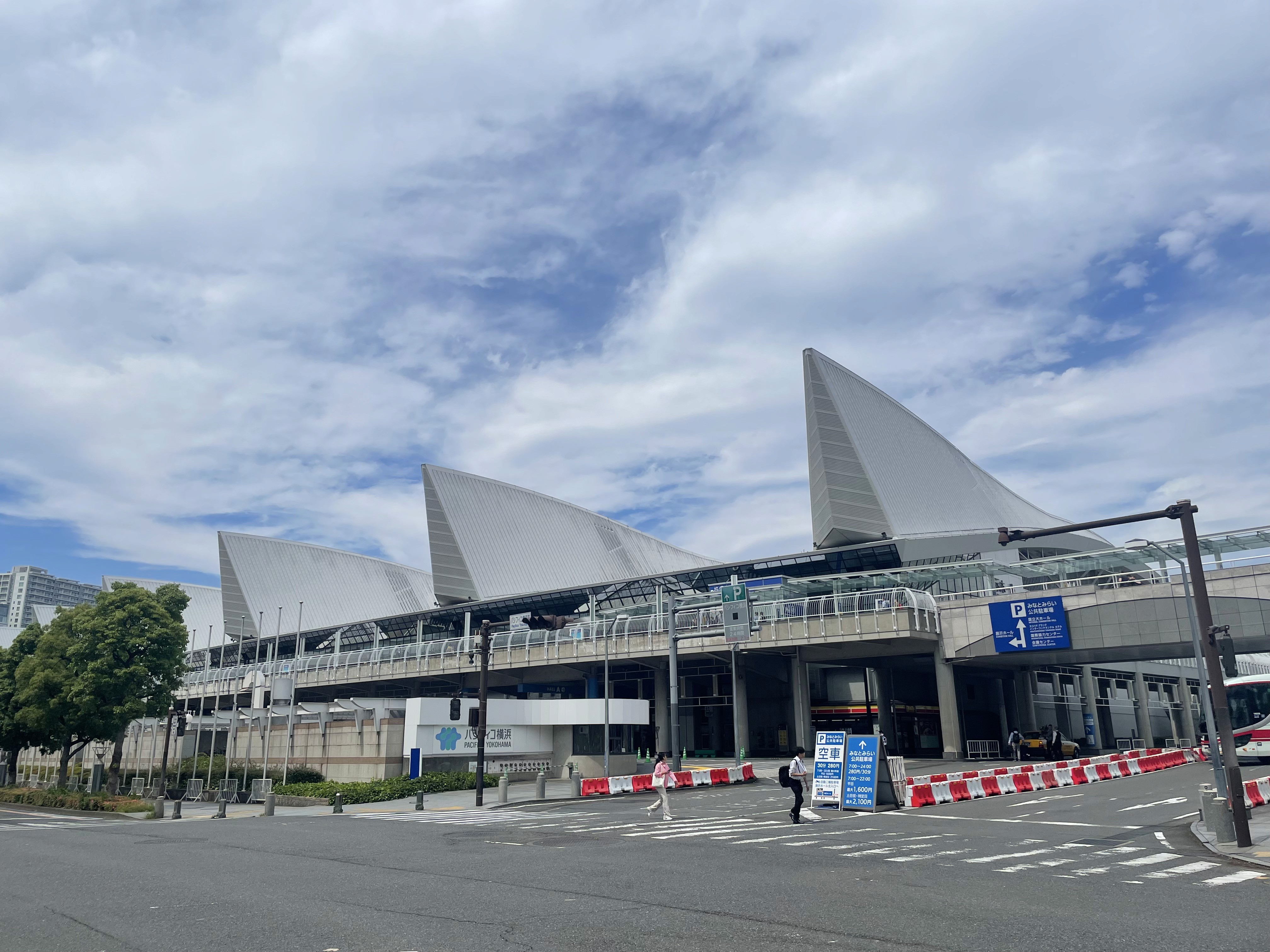
Pacifico Yokohama, the Venue for ICRA 2024
We walked from Sakuragicho Station, about a 20-minute walk from the venue. On the way, we began to see people wearing ICRA access badges. Eventually, we reached Pacifico Yokohama, a building facing the sea at the end of the boulevard.
Youthful Enthusiasm in Robotics
ICRA 2024 was full of youthful energy. It was impressive to see that the proportion of young researchers in their 20s and 30s was high, not only among the university challenge teams and paper presenters but also at company booths. We arrived on the 14th, the practical start of the main event, the Expo, and we could clearly see the busy atmosphere as researchers set up their booths, checked their robots, and students gathered in small groups to prepare for challenges. Witnessing the lively scenes throughout the venue made our hearts race with excitement, thinking about the future of robotics they would bring.
One of the most vibrant and dynamic events throughout the Expo was the F1TENTH Challenge. In this competition, teams create 1:10 scale autonomous racing cars with hardware and software to achieve the goal of “Don’t crash and minimize lap time.” The practice races were filled with excitement as race cars collided and toppled over, participants chased after them, and some were busy repairing and reprogramming the vehicles. Despite the intense activity, the participants’ focused expressions radiated their passion for robotics.
One participant from an Italian university, though shy, explained her robot with seriousness, saying, “This is where I belong,” showing her happiness despite the many challenges robotics still faces.
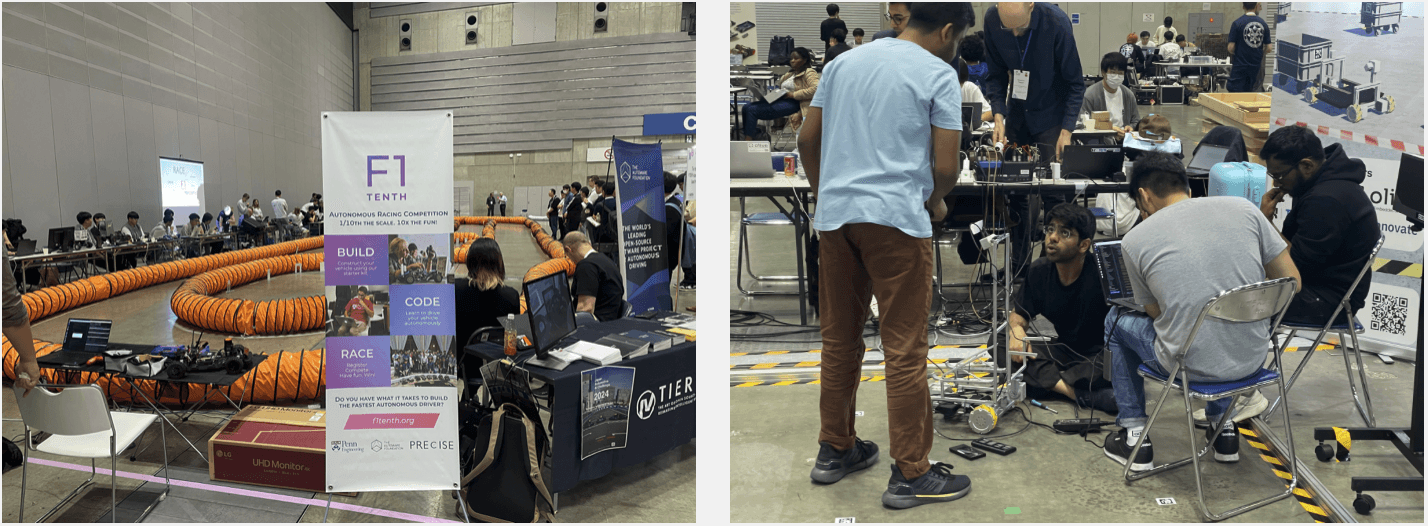
F1TENTH Autonomous Grand Prix
Another popular challenge was the Quadruped Robot Challenge (QRC), with participation from institutions such as Tsinghua University, KAIST, and Chiba University, supported by the National Institute of Standards and Technology (NIST) for arena design, maintenance, and operation. The level of preparation from the participants created an atmosphere of tension, even during rehearsal.
There were also other interesting challenges, such as the Food Topping Challenge themed around salmon roe rice bowl (Ikuradon) and the Future Convenience Store Challenge, evaluating how robots would serve customers in a virtual convenience store. These challenges highlighted the unique characteristics of the host country.

Unique Challenges
The poster sessions were held in the innermost corner of the Expo, with each booth filled with people eager to hear from the researchers. The researchers enthusiastically explained their work, energized by the audience’s interest, and exchanged questions, creating a lively atmosphere.
The Present and Future of Robotics
Throughout the Expo hall, quadruped robots, often called “robot dogs,” could be seen moving around. They skillfully climbed stairs, maintained balance even when pushed, and quickly stood back up after falling, showcasing their various capabilities. Many companies demonstrated significant technological progress.
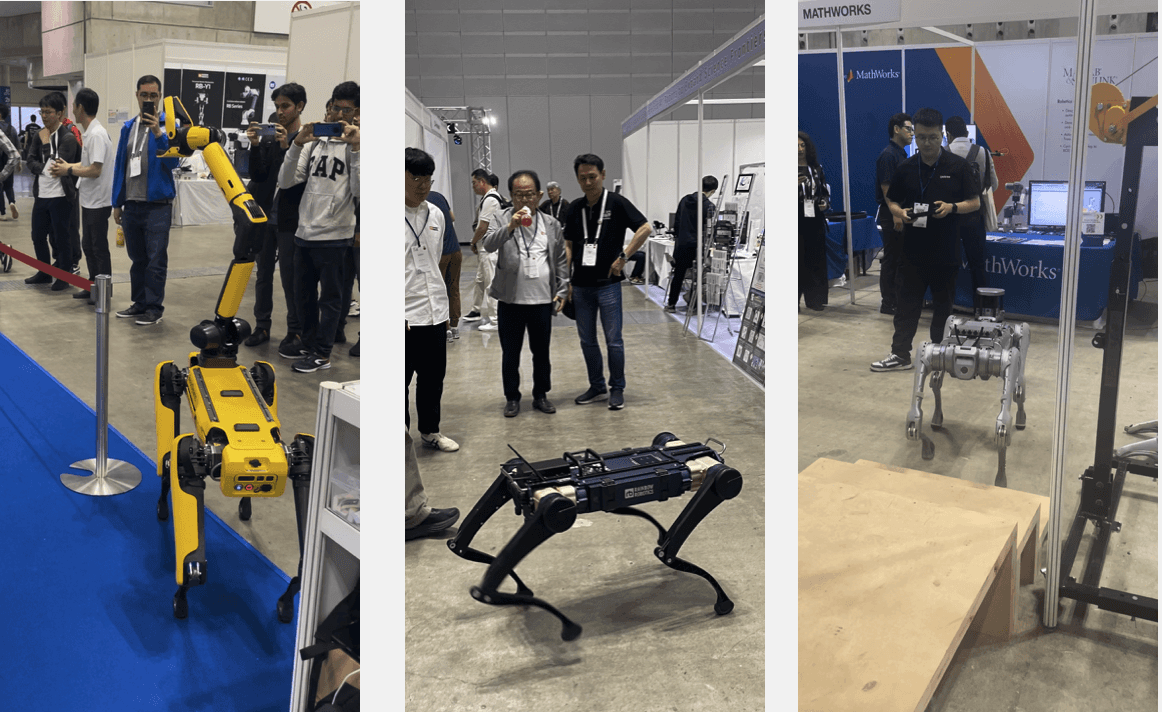
Quadruped Robots Roaming ICRA
Medical robots showcased accurate surgical procedures, and especially prominent were booths dedicated to robotic hands, including parts and sensors. Technologies allowing precise control over gripping force based on the object’s characteristics showed a high degree of completion. Efforts to design robotic hands resembling human hands increased the anticipation of their widespread use.
In line with the recent surge of interest in humanoids, many people were also drawn to humanoid robots at the Expo. Some robots demonstrated autonomous bipedal walking, while others relied on support structures. Representatives commonly mentioned two main concerns: 1) the demand for applications and use cases for humanoids and 2) the technical hurdles that need to be overcome to achieve fully functional hardware.
Unitree, a Chinese company known for its low-cost humanoid robots, attracted a massive crowd during a demonstration of the G1 robot, which recently gained attention in videos. We waited for the demo, but it was delayed due to further preparation time, and despite a few attempts, the movements remained somewhat incomplete.
Humanoids at this year’s Expo did not showcase any particularly advanced functions. Some suggested that the focus should be on robots with clear market demand, such as collaborative robots. It’s exciting to wonder if humanoids will quickly enter the market or if they remain a more distant future. What do you think?
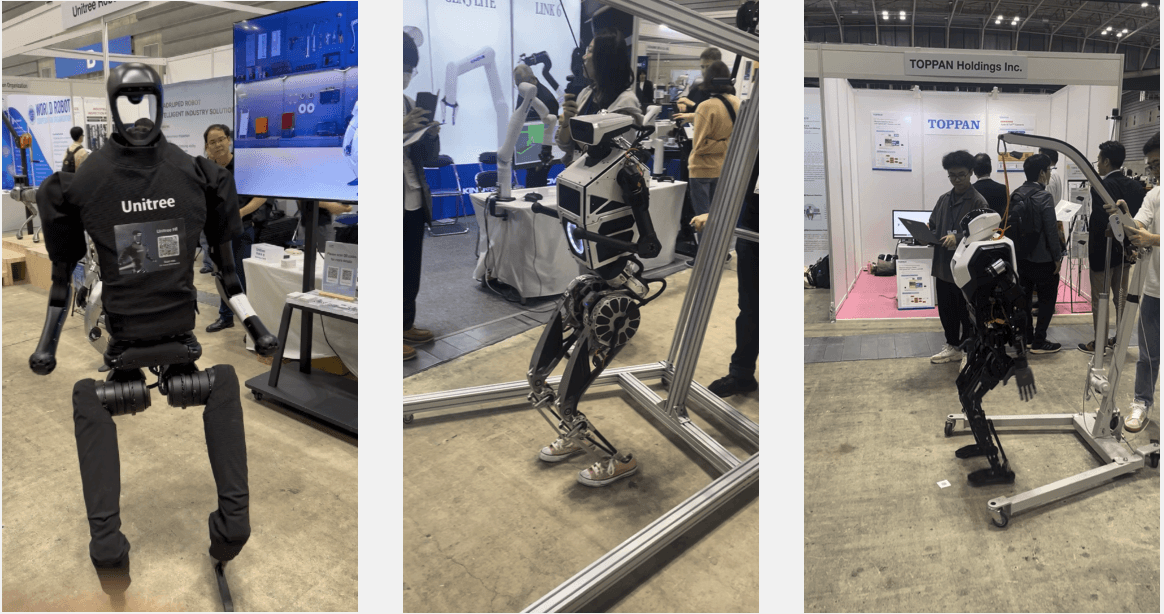
Humanoids Seen Throughout the Exhibition Hall
The Age of Robots
Korea, with a strong focus on the electrical and electronics industry, has the highest robot density globally. This has increased by an average of 6% over the past five years.
Outstanding entrepreneurial talent is entering the robotics field, seeing robots as the best solution to address societal challenges. With the explosive growth potential of startups, we look forward to the robotics era arriving even faster.
What We Found at ICRA 2024
The most rewarding part of the Expo was witnessing the passion of people creating something new and the process toward the future. Even before heading to ICRA, understanding the participating institutions and the industry trends was an educational experience in itself.
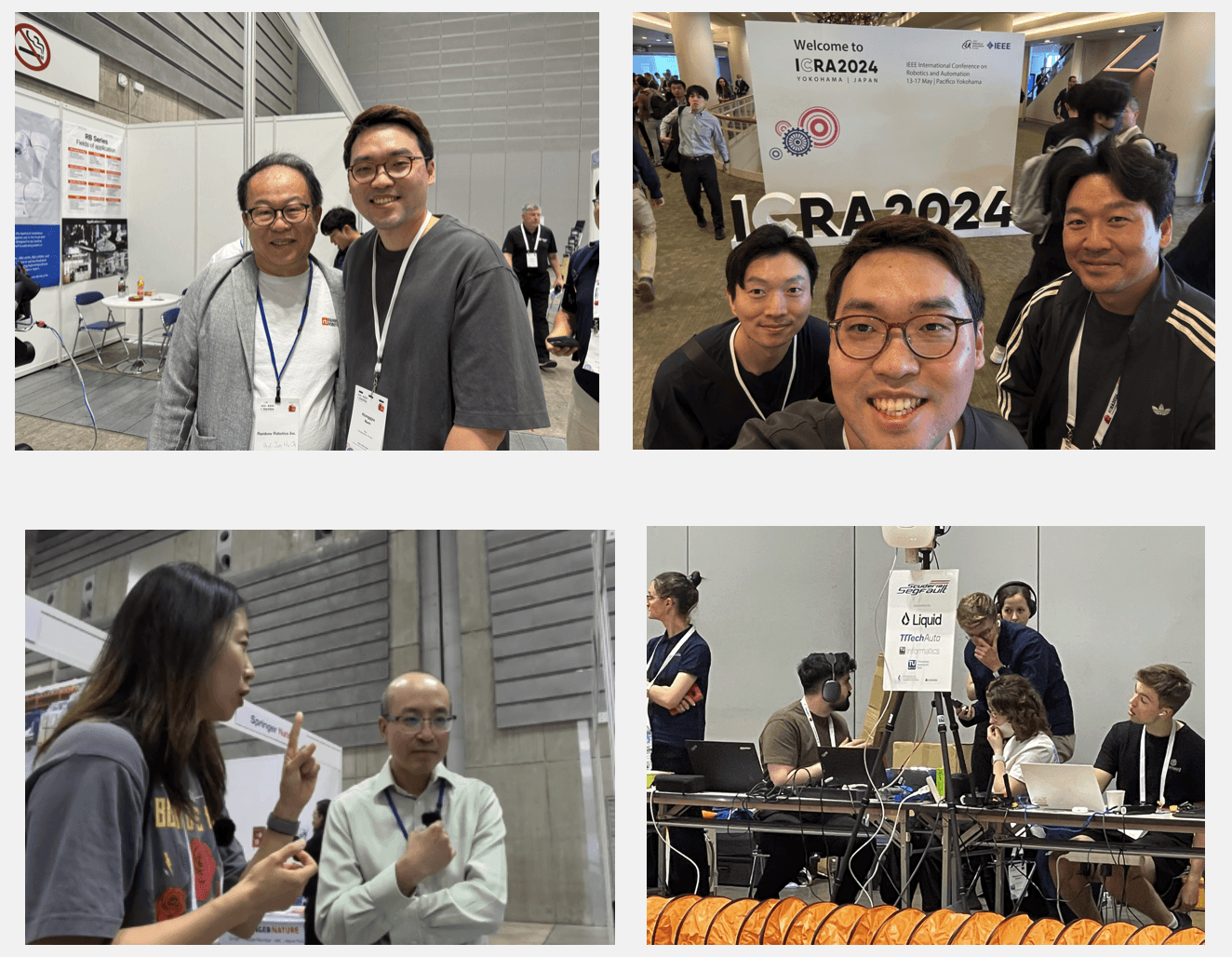
When people with vision and shared ideas gather in one place, energy bursts forth, and being part of that experience provided a healthy sense of motivation.
Robotics and Automation
ICRA 2024, held from May 13-17, was the largest event in the robotics field, gathering the three main pillars of the robotics ecosystem: businesses, academia, and talent from around the world. We witnessed a vibrant, youthful, and dynamic robotics industry, and we’re excited to share that atmosphere here.
ICRA 2024
The International Conference on Robotics and Automation (ICRA), hosted by IEEE (Institute of Electrical and Electronics Engineers), is the most prestigious conference in robotics and automation, ranking #1 in the robotics field on Google Scholar’s h-5 index. The event includes an Expo where companies and universities showcase research technologies and products, competitions where teams compete on specific missions, conferences, academic sessions, and poster presentations. Last year’s ICRA 2023 was held in London, and this year’s ICRA 2024 took place in Yokohama, Japan, with participation from over 1,000 institutions worldwide.

Pacifico Yokohama, the Venue for ICRA 2024
We walked from Sakuragicho Station, about a 20-minute walk from the venue. On the way, we began to see people wearing ICRA access badges. Eventually, we reached Pacifico Yokohama, a building facing the sea at the end of the boulevard.
Youthful Enthusiasm in Robotics
ICRA 2024 was full of youthful energy. It was impressive to see that the proportion of young researchers in their 20s and 30s was high, not only among the university challenge teams and paper presenters but also at company booths. We arrived on the 14th, the practical start of the main event, the Expo, and we could clearly see the busy atmosphere as researchers set up their booths, checked their robots, and students gathered in small groups to prepare for challenges. Witnessing the lively scenes throughout the venue made our hearts race with excitement, thinking about the future of robotics they would bring.
One of the most vibrant and dynamic events throughout the Expo was the F1TENTH Challenge. In this competition, teams create 1:10 scale autonomous racing cars with hardware and software to achieve the goal of “Don’t crash and minimize lap time.” The practice races were filled with excitement as race cars collided and toppled over, participants chased after them, and some were busy repairing and reprogramming the vehicles. Despite the intense activity, the participants’ focused expressions radiated their passion for robotics.
One participant from an Italian university, though shy, explained her robot with seriousness, saying, “This is where I belong,” showing her happiness despite the many challenges robotics still faces.

F1TENTH Autonomous Grand Prix
Another popular challenge was the Quadruped Robot Challenge (QRC), with participation from institutions such as Tsinghua University, KAIST, and Chiba University, supported by the National Institute of Standards and Technology (NIST) for arena design, maintenance, and operation. The level of preparation from the participants created an atmosphere of tension, even during rehearsal.
There were also other interesting challenges, such as the Food Topping Challenge themed around salmon roe rice bowl (Ikuradon) and the Future Convenience Store Challenge, evaluating how robots would serve customers in a virtual convenience store. These challenges highlighted the unique characteristics of the host country.

Unique Challenges
The poster sessions were held in the innermost corner of the Expo, with each booth filled with people eager to hear from the researchers. The researchers enthusiastically explained their work, energized by the audience’s interest, and exchanged questions, creating a lively atmosphere.
The Present and Future of Robotics
Throughout the Expo hall, quadruped robots, often called “robot dogs,” could be seen moving around. They skillfully climbed stairs, maintained balance even when pushed, and quickly stood back up after falling, showcasing their various capabilities. Many companies demonstrated significant technological progress.

Quadruped Robots Roaming ICRA
Medical robots showcased accurate surgical procedures, and especially prominent were booths dedicated to robotic hands, including parts and sensors. Technologies allowing precise control over gripping force based on the object’s characteristics showed a high degree of completion. Efforts to design robotic hands resembling human hands increased the anticipation of their widespread use.
In line with the recent surge of interest in humanoids, many people were also drawn to humanoid robots at the Expo. Some robots demonstrated autonomous bipedal walking, while others relied on support structures. Representatives commonly mentioned two main concerns: 1) the demand for applications and use cases for humanoids and 2) the technical hurdles that need to be overcome to achieve fully functional hardware.
Unitree, a Chinese company known for its low-cost humanoid robots, attracted a massive crowd during a demonstration of the G1 robot, which recently gained attention in videos. We waited for the demo, but it was delayed due to further preparation time, and despite a few attempts, the movements remained somewhat incomplete.
Humanoids at this year’s Expo did not showcase any particularly advanced functions. Some suggested that the focus should be on robots with clear market demand, such as collaborative robots. It’s exciting to wonder if humanoids will quickly enter the market or if they remain a more distant future. What do you think?

Humanoids Seen Throughout the Exhibition Hall
The Age of Robots
Korea, with a strong focus on the electrical and electronics industry, has the highest robot density globally. This has increased by an average of 6% over the past five years.
Outstanding entrepreneurial talent is entering the robotics field, seeing robots as the best solution to address societal challenges. With the explosive growth potential of startups, we look forward to the robotics era arriving even faster.
What We Found at ICRA 2024
The most rewarding part of the Expo was witnessing the passion of people creating something new and the process toward the future. Even before heading to ICRA, understanding the participating institutions and the industry trends was an educational experience in itself.

When people with vision and shared ideas gather in one place, energy bursts forth, and being part of that experience provided a healthy sense of motivation.
Robotics and Automation
ICRA 2024, held from May 13-17, was the largest event in the robotics field, gathering the three main pillars of the robotics ecosystem: businesses, academia, and talent from around the world. We witnessed a vibrant, youthful, and dynamic robotics industry, and we’re excited to share that atmosphere here.
ICRA 2024
The International Conference on Robotics and Automation (ICRA), hosted by IEEE (Institute of Electrical and Electronics Engineers), is the most prestigious conference in robotics and automation, ranking #1 in the robotics field on Google Scholar’s h-5 index. The event includes an Expo where companies and universities showcase research technologies and products, competitions where teams compete on specific missions, conferences, academic sessions, and poster presentations. Last year’s ICRA 2023 was held in London, and this year’s ICRA 2024 took place in Yokohama, Japan, with participation from over 1,000 institutions worldwide.

Pacifico Yokohama, the Venue for ICRA 2024
We walked from Sakuragicho Station, about a 20-minute walk from the venue. On the way, we began to see people wearing ICRA access badges. Eventually, we reached Pacifico Yokohama, a building facing the sea at the end of the boulevard.
Youthful Enthusiasm in Robotics
ICRA 2024 was full of youthful energy. It was impressive to see that the proportion of young researchers in their 20s and 30s was high, not only among the university challenge teams and paper presenters but also at company booths. We arrived on the 14th, the practical start of the main event, the Expo, and we could clearly see the busy atmosphere as researchers set up their booths, checked their robots, and students gathered in small groups to prepare for challenges. Witnessing the lively scenes throughout the venue made our hearts race with excitement, thinking about the future of robotics they would bring.
One of the most vibrant and dynamic events throughout the Expo was the F1TENTH Challenge. In this competition, teams create 1:10 scale autonomous racing cars with hardware and software to achieve the goal of “Don’t crash and minimize lap time.” The practice races were filled with excitement as race cars collided and toppled over, participants chased after them, and some were busy repairing and reprogramming the vehicles. Despite the intense activity, the participants’ focused expressions radiated their passion for robotics.
One participant from an Italian university, though shy, explained her robot with seriousness, saying, “This is where I belong,” showing her happiness despite the many challenges robotics still faces.

F1TENTH Autonomous Grand Prix
Another popular challenge was the Quadruped Robot Challenge (QRC), with participation from institutions such as Tsinghua University, KAIST, and Chiba University, supported by the National Institute of Standards and Technology (NIST) for arena design, maintenance, and operation. The level of preparation from the participants created an atmosphere of tension, even during rehearsal.
There were also other interesting challenges, such as the Food Topping Challenge themed around salmon roe rice bowl (Ikuradon) and the Future Convenience Store Challenge, evaluating how robots would serve customers in a virtual convenience store. These challenges highlighted the unique characteristics of the host country.

Unique Challenges
The poster sessions were held in the innermost corner of the Expo, with each booth filled with people eager to hear from the researchers. The researchers enthusiastically explained their work, energized by the audience’s interest, and exchanged questions, creating a lively atmosphere.
The Present and Future of Robotics
Throughout the Expo hall, quadruped robots, often called “robot dogs,” could be seen moving around. They skillfully climbed stairs, maintained balance even when pushed, and quickly stood back up after falling, showcasing their various capabilities. Many companies demonstrated significant technological progress.

Quadruped Robots Roaming ICRA
Medical robots showcased accurate surgical procedures, and especially prominent were booths dedicated to robotic hands, including parts and sensors. Technologies allowing precise control over gripping force based on the object’s characteristics showed a high degree of completion. Efforts to design robotic hands resembling human hands increased the anticipation of their widespread use.
In line with the recent surge of interest in humanoids, many people were also drawn to humanoid robots at the Expo. Some robots demonstrated autonomous bipedal walking, while others relied on support structures. Representatives commonly mentioned two main concerns: 1) the demand for applications and use cases for humanoids and 2) the technical hurdles that need to be overcome to achieve fully functional hardware.
Unitree, a Chinese company known for its low-cost humanoid robots, attracted a massive crowd during a demonstration of the G1 robot, which recently gained attention in videos. We waited for the demo, but it was delayed due to further preparation time, and despite a few attempts, the movements remained somewhat incomplete.
Humanoids at this year’s Expo did not showcase any particularly advanced functions. Some suggested that the focus should be on robots with clear market demand, such as collaborative robots. It’s exciting to wonder if humanoids will quickly enter the market or if they remain a more distant future. What do you think?

Humanoids Seen Throughout the Exhibition Hall
The Age of Robots
Korea, with a strong focus on the electrical and electronics industry, has the highest robot density globally. This has increased by an average of 6% over the past five years.
Outstanding entrepreneurial talent is entering the robotics field, seeing robots as the best solution to address societal challenges. With the explosive growth potential of startups, we look forward to the robotics era arriving even faster.
What We Found at ICRA 2024
The most rewarding part of the Expo was witnessing the passion of people creating something new and the process toward the future. Even before heading to ICRA, understanding the participating institutions and the industry trends was an educational experience in itself.

When people with vision and shared ideas gather in one place, energy bursts forth, and being part of that experience provided a healthy sense of motivation.
FOUNDER'S PARTNER
FOUNDER'S PARTNER
ⓒ 2024 Klim ventures
ⓒ 2024 Klim ventures